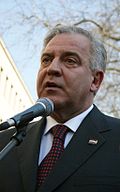2003 Croatian parliamentary election
| |||||||||||||||||||||||||||||||||||||||||||||||||||||||||||
All 151 seats to Hrvatski sabor 76 seats needed for a majority | |||||||||||||||||||||||||||||||||||||||||||||||||||||||||||
|---|---|---|---|---|---|---|---|---|---|---|---|---|---|---|---|---|---|---|---|---|---|---|---|---|---|---|---|---|---|---|---|---|---|---|---|---|---|---|---|---|---|---|---|---|---|---|---|---|---|---|---|---|---|---|---|---|---|---|---|
| Turnout | 61.7% | ||||||||||||||||||||||||||||||||||||||||||||||||||||||||||
| |||||||||||||||||||||||||||||||||||||||||||||||||||||||||||
 Results of the election in each of the ten electoral districts of Croatia: the party with the majority of votes in each electoral unit. HDZ: blue; SDP coalition: red | |||||||||||||||||||||||||||||||||||||||||||||||||||||||||||
| |||||||||||||||||||||||||||||||||||||||||||||||||||||||||||


Parliamentary elections to elect all 151 members of the Croatian Parliament were held on November 23, 2003.[1] They were the 5th parliamentary elections to take place since the first multi-party elections in 1990. Turnout was 61.7%. The result was a victory for the opposition Croatian Democratic Union party (HDZ) which won a plurality of 66 seats, but fell short of the 76 needed to form a government. HDZ chairman Ivo Sanader was named the 8th Prime Minister of Croatia on 23 December 2003, after parliament passed a confidence motion in his government cabinet, with 88 Members of Parliament voting in favor, 29 against and 14 abstaining. The ruling coalition, consisting of the Social Democratic Party (SDP), Croatian People's Party (HNS), Croatian Peasant Party (HSS), Party of Liberal Democrats (Libra) and the Liberal Party (LS) did not contest the elections as a single bloc. Namely, the SDP ran with the Istrian Democratic Assembly (IDS), the Party of Liberal Democrats (Libra) and the Liberal Party (LS), HNS ran with the Alliance of Primorje-Gorski Kotar (PGS) and the Slavonia-Baranja Croatian Party (SBHS), while HSS ran on its own.
General information
There are 10 electoral units based on geography and population. In each unit, 14 candidates are elected on proportional electoral system. The election threshold is 5%.
In addition, 8 candidates are elected to represent national minorities.
The citizens that live outside Croatian borders vote in a separate electoral unit. The number of representatives elected from this unit will be determined after the elections, based on how many people actually vote in Croatia, so that there is equal value of votes both inside and outside Croatia. For reference, the number of diaspora seats in the 2000-2003 Sabor was six.
Total: 140 domestic seats + 8 minority seats + 4 diaspora seats.[2]
Distribution of minority seats:[3]
- Serbs: 3
- Hungarians: 1
- Italians: 1
- Czechs and Slovaks: 1
- Austrians, Bulgarians, Germans, Poles, Romani, Romanians, Rusyns, Russians, Turks, Ukrainians, Vlachs and Jews: 1
- Albanians, Bosniaks, Montenegrins, Macedonians, Slovenes: 1
Parties and coalitions
Pre-election coalitions:[3]
- DC and HSLS, in all electoral units
- SDP and IDS, in the 8th electoral unit (the county of Istria et al.)
- HB and HIP, in all electoral units
- SDP and Libra in the 2nd, 3rd, 4th and 10th electoral unit
- SDP and LS, in the 4th and 6th electoral unit
- HNS and SBHS, in the 4th and 5th electoral unit (counties of Slavonia)
- HNS and PGS, in the 7th and 8th electoral unit (Northern seacoast counties)
Summary of votes and seats
Template:Croatian parliamentary election, 2003
The number of diaspora mandates is reduced by 2 compared to previous elections due to somewhat lower diaspora turnout. Due to distribution according to the d'Hondt method, the independent lists for diaspora won't be allocated seats, even though they received over 5% of total votes.
National minorities elected 8 representatives through a separate election system: Vojislav Stanimirović (22,2% of votes), Milorad Pupovac (21,7%) and Ratko Gajica (13,8%) for the Serb national minority, Jene Adam (42%) for the Hungarian minority, Furio Radin (79,8%) for the Italian minority, Zdenka Čuhnil (39,2%) for the Czech and Slovak minorities, Nikola Mak (14,3%) for the Austrian, Bulgarian, German, Jewish, Polish, Roma, Romanian, Rusyn, Russian, Turkish, Ukrainian, Vlach minorities and Šemso Tanković (59,1%) for the Albanian, Bosniak, Macedonian, Montenegrin and Slovene minorities.
Ivo Sanader of Croatian Democratic Union (HDZ) was appointed as Prime Minister by the President and confirmed by the Croatian Parliament.
The new Government was formed of 13 HDZ ministers and 1 of Democratic Centre.[4]
See also
References
- ^ Odluka o raspisivanju izbora za zastupnike u Hrvatskom saboru
- ^ Izvješće OESS/ODIHR-ove izborne promatračke misije, Organization for Security and Co-operation in Europe, pdf
- ^ a b Cite error: The named reference
hr 2003 official resultswas invoked but never defined (see the help page). - ^ VLADA Republike Hrvatske - kronologija. Vlada: 9 / predsjednik Vlade: Dr. sc. Ivo Sanader



